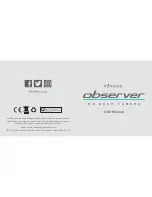
Oculus handbook Issue 2 January 2013
Anti-blooming: Overload margin greater than 1000x.
Dark current: Less than 0.1 electrons/second @ + 10C ambient.
Data format: 16 bits.
System gain: 0.3 electrons per ADU
Lens details:
1.55mm FL F/2 180 degree ‘Fish Eye’
Computer Interface: Built-in USB 2.0 compatible interface.
Image download time: Typically 0.6 seconds at full resolution using USB 2.0.
Power requirements: Camera is USB powered, dew heater requires 12v at 1 amp max.
Input connection: ‘Mini B’ USB socket for USB2.0 and a 2.1mm jack for +12v heater supply.
Cooling system: Ambient air cooling.
Viewing dome: High quality polycarbonate hemisphere (replaceable)
Overall size:
150mm tall x 95mm diameter
Installing the Oculus:
A new 32 bit XP installation will require the driver files SXVIO.sys and Generic.sys, plus the
SXVIO_Oculus.inf file. A 64 bit machine will require our 64 bit driver package ‘BlockIO64.zip’ or the
new Windows 8 version. I recommend using the new ‘signed’ Windows 8 drivers for any machine
running Windows 7, or above (32 bit versions are included in the download). All are available from our
web pages, if required (
http://www.sxccd.com/drivers-downloads
).
Running the ‘Setup.exe’ file on the supplied CD, will install the drivers and operating software
automatically. If you are installing manually, copy the appropriate files into a convenient folder on
drive C and then connect the USB cable to the Oculus. Point the installer at this folder when it asks for
the location of the drivers and you should see it set up the hardware as a ‘BlockIOClass’ device in
Device Manager.
The Oculus control software is Oculus_USB.exe and the latest version may be downloaded from the
Starlight Xpress web site
http://www.sxccd.com/drivers-downloads
, if necessary. Copy the exe file
and dlls into a folder on drive C and run the exe file to start the software. You need Oculue_USB.exe,
bwcc32.dll and wsc32.dll to run the program. If any files are missing, you can find them on our
downloads web page. Alternatively, ‘PHD’, ‘AstroArt’ and ‘MaximDL’ support the Oculus (as the H9
or SuperStar) and may be preferred. Note that the Oculus may show up as an ‘SXV-H9’ or as
‘Unknown’ in some software, but it should still work OK.
Setting up and using the Oculus:
The best site for your Oculus camera will depend to a great degree on your surroundings and nearby
sources of artificial light. An all-sky lens will image everything in your area and the reflections of
artificial lights in the dome and lens can be objectionable. Try to locate it in a shadowed area with as

























